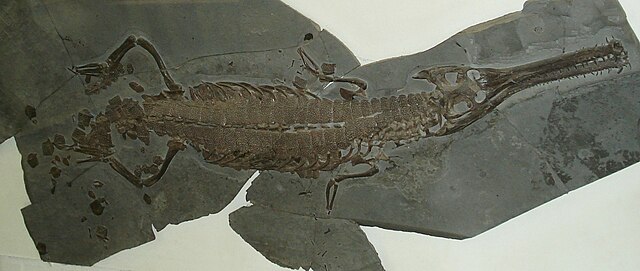Teleosauridae is a family of extinct typically marine crocodylomorphs similar to the modern gharial that lived during the Jurassic period. Teleosaurids were thalattosuchians closely related to the fully aquatic metriorhynchoids, but were less adapted to an open-ocean, pelagic lifestyle. The family was originally coined to include all the semi-aquatic thalattosuchians and was equivalent to the modern superfamily Teleosauroidea. However, as teleosauroid relationships and diversity was better studied in the 21st century, the division of teleosauroids into two distinct evolutionary lineages led to the establishment of Teleosauridae as a more restrictive family within the group, together with its sister family Machimosauridae.
Teleosauridae
Thalattosuchia is a clade of mostly marine crocodylomorphs from the Early Jurassic to the Early Cretaceous that had a cosmopolitan distribution. They are colloquially referred to as marine crocodiles or sea crocodiles, though they are not members of Crocodilia and records from Thailand and China suggest that some members lived in freshwater. The clade contains two major subgroupings, the Teleosauroidea and Metriorhynchoidea. Teleosauroids are not greatly specialised for oceanic life, with back osteoderms similar to other crocodyliformes. Within Metriorhynchoidea, the Metriorhynchidae displayed extreme adaptions for life in the open ocean, including the transformation of limbs into flippers, the development of a tail fluke, and smooth, scaleless skin, and probably gave live birth, seemingly uniquely among archosaurs.
Image: Platysuchus multiscrobiculatus 1
Image: Cricosaurus albersdoerferi
Life restoration of Machimosaurus (Machimosauridae, Teleosauroidea)



